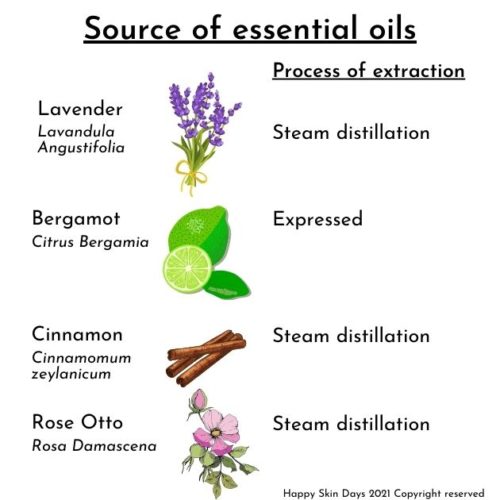There is no fixed definition of what a natural essential oil is.
An essential oil (e.g.) lavender is derived from a plant, herb, fruit, roots, leaves etc and is a mixture of chemicals that in the plant perform vital functions. E.g., contribute to the smell of the flowers (thereby attracting e.g., bees). These chemicals are principally organic and volatile (that is, easily evaporate and/or prone to oxidation).

These chemicals when used in cosmetics or other leave on products (e.g.) massage oil, can give certain therapeutic value. For example, lavender essential oil is a calming fragrance that reduces stress levels (thereby promoting sleep), its smell relieves headaches and it can act as an antiseptic. On the skin it softens the skin and can have regenerative effects.
Therefore, natural essential oils are 100% derived from plants, but can be very potent. Tisserand et al point out that essential oils can be 50-100+ stronger than the concentration you would ordinarily find in a plant/flower. This makes essential oils extremely potent.
A more technical definition from the European Chemicals Agency is: “An essential oil is defined as a volatile part of a natural product, which can be obtained by distillation, steam distillation or expression in the case of citrus fruits. It contains mostly volatile hydrocarbons. Essential oils are derived from various sections of plants. The oil is “essential” in the sense that it carries a distinctive scent or essence of the plant“
The composition of essential oils
Essential oils are not one compound, but are a bunch of compounds. For example, Bouzouita Nabiha et al, analysed the chemical composition of bergamot EO originating from Tunisia, and this is the list of all the chemical constituents that they identified:

The actual composition of an essential oil (assuming it is not at all adulterated) will depend on its source. In the same study, Bouzouita Nabiha et al refer to Italian Bergamot essential oil, being of the highest quality and its composition being different.
What are potentially adverse reactions to essential oils?
Given the composition of essential oils is not ONE compound, its important that you appreciate that the adverse reactions to essential oils are usually towards particular compound (s) that the oil contains.
Continuing with the example of Bergamot essential oil, it contains two compounds: bergapten and furanocoumarin, which may cause adverse reactions. Bergapten is a potential carcinogen and its use (at least in the EU is regulated). Furanocoumarin are commonly found in citrus fruits and can make skin photosensitive. It is completely possible to buy Furanocoumarin-free essential oils. These are definitely more expensive, but I would look out for these.
The harmful effects of essential oils
These include:
- Carcinogenic
- Organ toxicity,
- Cytotoxicity (toxic to cells)
- Acute toxicity (ingest enough essential oils and you might die….that is a thing)
- Reproductive toxicity
but Skincare!
As this blog is about skincare, I am 100% ignoring non-skincare side effects. The adverse skin effects of essential oil will depend on a number of factors including:
- Type of essential oil used
- Dosage of EO (including concentration)
- Site on the body
- Age (children are more sensitive than adults) and so on
repeated exposure to undiluted essential oils, is very likely over time going to cause adverse skin reactions. Even before I started my course material, there was a whole entire lecture on how to use essential oils safely – namely, use gloves and never touch essential oils directly to the skin.
Adverse skin reactions are broadly
- Photosensitivity
- Irritation
- Sensitization
Photosensitivity is the simplest to explain. Some essential oils (e.g.) bergamot essential oil, will make skin more sensitive to UV radiation, but only when applied to the skin and it would appear just the UVA radiation. Furanocoumarins are compounds found in citrus essential oils and one of the adverse photosensitive reactions that they may cause is post-inflammation hyper-pigmentation in adverse cases.
Rarely, photosensitivity may take the form of a photoallergic reaction to UV light. Essentially there is an allergic reaction caused by UV radiation because of essential oil usage. This is an extremely uncommon reaction.
Essential oils can “irritate” the skin and such reactions tend to be immediate (irritant contact dermatitis). There is no lasting harm done because the skin reverts back to its normal self once the culprit is removed.
E.g., of irritating oils are mustard oil, horseradish, immortelle absolute, sage oil and garlic oil.
Remember it’s the dose and concentration of essential oils that will determine irritation level as well. E.g, 0.5% immortelle essential oil should be non-irritating to most people, but probably not 5%.
Finally, sensitization refers to the skin reaction that is best described as a visible reddening of the skin. Sensitization may be immediate (e.g.) a peanut allergy or delayed (e.g.) a pigmentation reaction that is not caused by UV radiation.
Fragrance contain many allergens that cause sensitization. Therefore in the EU, there is strict regulation of 26 allergens, some of which are found in essential oils.
And that’s it for today. In part 3, we will be looking at essential oil safety, but before that a note on ingesting essential oils
Should you ever ingest essential oils?
No.
I admit that many food products may contain essential oils. Orange essential oil immediately springs to mind. BUT that does not mean anyone should go around ingesting essential oils especially to alleviate a particular condition. Why would you? The potential toxicity to your organs in flushing out toxins far outweighs any benefit.
See also